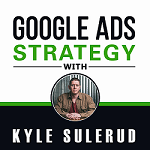Today I have a guest host who’s going to be answering a question for me. I’ve asked my friend, Nik Armenis to come on and answer a question that came in about Google ads for e-commerce. He’s the expert there, so I like to deflect all of the e-commerce questions over to him.
The question comes from Sarah and she says:
“I’ve set up a Shopify page and I’m doing dropshipping. So anything around how to promote my store and niche products would be great. I have only used Facebook ad campaigns so far which help but it can get very expensive”.
Nik:
Sarah, thank you very much for the question. This is an area I really, really know well and specialize in. So hopefully I’ll be able to give you some really good insights.
Now, if you are already advertising on Facebook, my suggestion to people whenever I teach people how to use Google for e-commerce in general and dropshipping as well, the best way you can utilize it is if you’re already getting traffic, make use of it.
So what I suggest is, start remarketing first on Google. Start your remarketing on Shopping, start remarketing on the Display Network, have a branded Search campaign, and also have in place some Display remarketing as well. Remarket across the board.
And from there, we start to branch out a bit.
You can actually utilize the YouTube network to start remarketing there. The reason I say let’s start remarketing is, it tends to give you the highest return on investment. You can then use the funds that you get from there to reinvest into cold traffic.
Once we branch out, from there:
To do the remarketing you’re going to have to have all those audiences set up. Now from here, what I suggest is that you build campaigns for cold traffic and then overlay similar audiences or in-market audiences or something along those lines. So audiences that you have set up in Analytics, especially what Google is going to do, is it’s going to create some similar to your old visitors, and some similar to your “add to cart”, some similar to your purchases.
Now all this depends on how much traffic you’re getting back. If you don’t have big enough audiences, you’re gonna have to branch out in totally cold traffic. The best way to do that for someone starting out, (and I know a lot of people are going to shake in their boots), is to create a campaign and have all your products in there. The trick though, is you’re gonna have to bid really, really low.
Now, people tell me “Oh, this doesn’t work. Google Shopping needs to be segmented.” Yes, best practice is: Segment your campaigns, either using custom labels or whatever way you want to do, a price point margin.
The reason they’re saying that is you need to be able to control the bidding. Now, if you don’t want to go to that extent, and I suggest starting out to learn the ropes, start a campaign and bid really low. Bid under 30 cents, even 25 cents or 20 cents. Bid really, really low on a small budget and start to get a hang of how Google Shopping works.
Then you can start optimizing. You can start adding negative keywords, removing any products that are chewing up your ad spend, checking your merchant feed for any errors. You’re going to learn the process of optimizing and how Google Ads work. So that would be my suggestion.
As you get more advanced, you can start doing those more advanced segmentation tactics. So the reason people segment campaigns is (and you’re going to hear this a lot) you need the control of :
- Keywords
- Biddings
So if you group like products, you’re gonna be able to control the keywords that you add to your negative keywords. If you start appearing in your search term report for something irrelevant, you added as a negative keyword. If you bunch all your products into one campaign, it removes that control, and it also removes the bidding control quite a bit as well.
The reason for that is you can obviously bid much higher for a product that has a $500 margin versus one that has a $50 margin. That’s the reason I suggest doing that one single campaign. And from there, you can start expanding it into cold search and stuff, utilizing the key terms, the search terms that pop up in the search terms report.
I hope that is a little bit of a crash course. Obviously, I could go on talking about this for hours and hours and hours, and I do on my YouTube channel and within my group as well. And I’m sure we’re going to be covering a lot more of that in the podcast. Okay, so, all the best for your business, Sarah, and I hope you found this answer useful.
========================================
Kyle:
Thank you very much, Nik for answering that question.
Nik has a Facebook group that I recommend joining if you’re doing any type of work for e-commerce businesses when it comes to Google ads. If you just go to Facebook and type “Google Ads for e-commerce”, his group should come up. It’s actually called “Google ads for e-commerce, entrepreneurs, and agency business owners”. That’s a great way to go learn more about Google ads for e-commerce.
